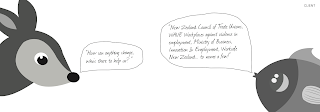A simple explanation of each spread:
Cover:
The cover begins the speech bubble aesthetic, it's simplistic, bold and sets the scene for the story being told by victims of bullying. 'Working within the food chain' plays with the metaphor we chose to use with the animals.
Issue:
The issue page includes our first environment with the lion and deer, the deer is explaining how it feels about the bullying situation. This gives an emotional and personal take on the issue. Stats are used to introduce the issue. 'In the lions den' is a known play on words, meaning being in a place of danger/risk. We have a clear heading, subheadings and body text.
Background:
Set out in the same manner as the issue page, this time with the two birds. Once again a play on words in relation to the animal used. The small birds down the right represent the many victims of bullying in the workplace. This spread is important as it informs people on what is actually considered bullying.
Audience:
Same as previous two, keeping cohesive. Fish and shark scenario. Minimal but to the point information.
Audience Needs:
This page is where the brief visually changes. We see the fish mixing with the sharks showing the fish making progress in confronting the issue even in the risky situation. The headings are no longer a play on words but represent the information.
Client:
The client page is unique from the others, This is the different environment victims communicating to inform each other of the help available, the help being the clients. The use of cropping changes up the layout to keep it interesting.
Client Motivation:
The client motivation is giving more detail on the organizations listed, mainly the union. The victim animals have now come together and are working towards an improved workplace and well-being. There is now hope for change.
Barriers:
We bring in the 'bully' animals again together. They are seen as part of the barriers as a common barrier is fear of the bully. I think many victims can relate to the barriers.
Desired Action:
Power in packs not only links to the animal kingdom, but suggests if you join forces with others you will have a louder voice and more power. The desired action really is to inform victims of what workplace bullying is, that it is unacceptable in any situation, there are ways of dealing with it and people out there willing to help. Its about giving victims hope and empowering them to stand up strong. All the animals and their groups have joined together now, an unbeatable force.
222.358 VCD: Making a Difference
Tuesday, 11 August 2015
Monday, 10 August 2015
Visual progression
We started to play around with how we wanted to layout our characters and tell the story
We choose to include speech bubbles to give the animals a voice and provoke emotion within the viewer. The speech bubble with a 'hand-drawn' type font in contrast with the clean information pages creates a visual dynamic that we will carry through the whole brief.
Sunday, 9 August 2015
Saturday, 8 August 2015
Referencing Resources
References to websites that helped source our information
WAVE- Workplaces Against Violence in Employment, 2012.
http://www.wave.org.nz/
Ministry of Buisness, Innovation & Employment, New Zealand Government, 2009. http://employment.govt.nz/er/services/law/case/themes/2009-08-workplace-bullying.asp
10 Tips for dealing with workplace bullying, New Zealand Herald, 2014.
http://www.nzherald.co.nz/business/news/article.cfm?c_id=3&objectid=11339691
Workplace Bullying, 2015.
http://nobullying.com/workplace-bullying/
http://nobullying.com/bullying-statistics-in-new-zealand/
New Zealand Council of Trade Unions- Te Kauae Kaimahi,
Rights and Protection, 2010.
http://union.org.nz/rights
Preventing and responding to workplace bullying, WorkSafe New Zealand, 2014.
http://www.business.govt.nz/worksafe/information-guidance/all-guidance-items/bullying-guidelines/workplace-bullying
Rise in bullying complaints, national, 2014.
http://www.stuff.co.nz/national/10667416/Big-rise-in-workplace-bullying-complaints
http://www.stats.govt.nz/
WAVE- Workplaces Against Violence in Employment, 2012.
http://www.wave.org.nz/
Ministry of Buisness, Innovation & Employment, New Zealand Government, 2009. http://employment.govt.nz/er/services/law/case/themes/2009-08-workplace-bullying.asp
10 Tips for dealing with workplace bullying, New Zealand Herald, 2014.
http://www.nzherald.co.nz/business/news/article.cfm?c_id=3&objectid=11339691
Workplace Bullying, 2015.
http://nobullying.com/workplace-bullying/
http://nobullying.com/bullying-statistics-in-new-zealand/
New Zealand Council of Trade Unions- Te Kauae Kaimahi,
Rights and Protection, 2010.
http://union.org.nz/rights
Preventing and responding to workplace bullying, WorkSafe New Zealand, 2014.
http://www.business.govt.nz/worksafe/information-guidance/all-guidance-items/bullying-guidelines/workplace-bullying
Rise in bullying complaints, national, 2014.
http://www.stuff.co.nz/national/10667416/Big-rise-in-workplace-bullying-complaints
http://www.stats.govt.nz/
Subscribe to:
Posts (Atom)























